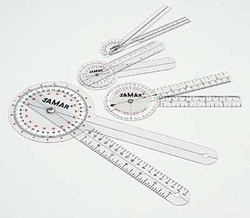Range of Motion

Image 8
Range of Motion measurements help to determine if there are asymmetries occurring from one side to the other as well as to determine if any joint limitations occur. End feels can be assessed during range of motion to determine if a bony, soft, or firm end feel is present. Range of motion measurements are also a good tool to use for charting progress.
Hip
Birth-2 Years
- Flexion: 136 ̊
- Extension: -1 ̊
- Abduction: 57 ̊
- Adduction: 17 ̊ ± 4 ̊
- Medial Rotation: 38 ̊
- Lateral Roation: 70 ̊
18 Months-19 Years
- Flexion: 123 ̊ ± 6 ̊
- Extension: 7 ̊ ± 7 ̊
- Abduction: 52 ̊ ± 9 ̊
- Adduction: 28 ̊ ± 4 ̊
- Medial Rotation: 50 ̊ ± 6 ̊
- Lateral Rotation: 51 ̊ ± 6 ̊
Knee
Birth-2 Years
- Flexion: 148 ̊ - 159 ̊
- Extension: -4 ̊
18 Months-19 Years
- Flexion: 144 ̊ ± 5 ̊
- Extension: -2 ̊ ± 3 ̊
Ankle/Foot
Birth-2 Years
- Dorsiflexion: 48 ̊
- Plantarflexion: 56 ̊
- Inversion: 99 ̊ ± 6 ̊
- Eversion: 82 ̊ ± 9 ̊
18 Months-19 Years
- Dorsiflexion: 13 ̊ ± 5 ̊
- Plantarflexion: 58 ̊ ± 6 ̊
- Inversion: 38 ̊ ± 5 ̊
- Eversion: 22 ̊ ± 5 ̊
